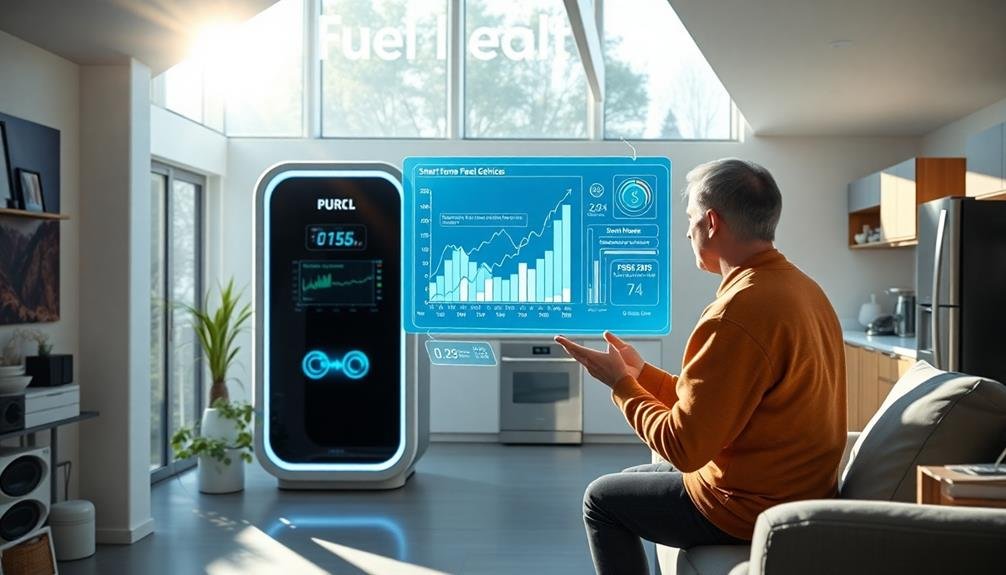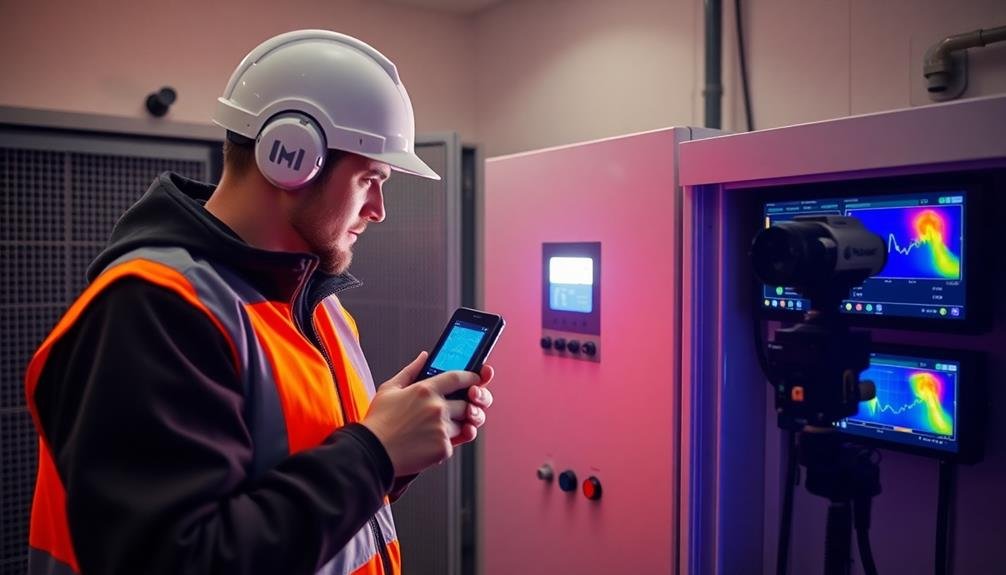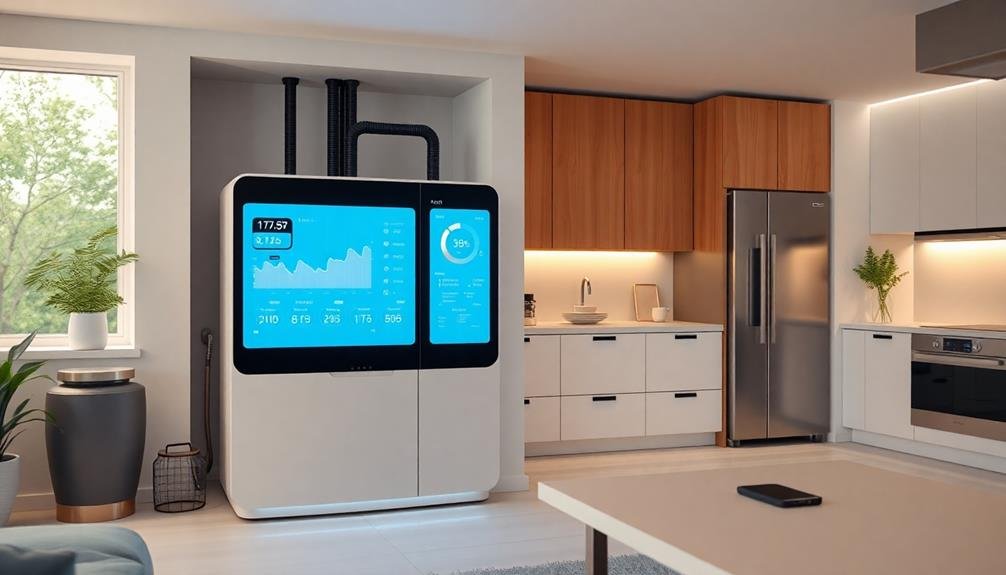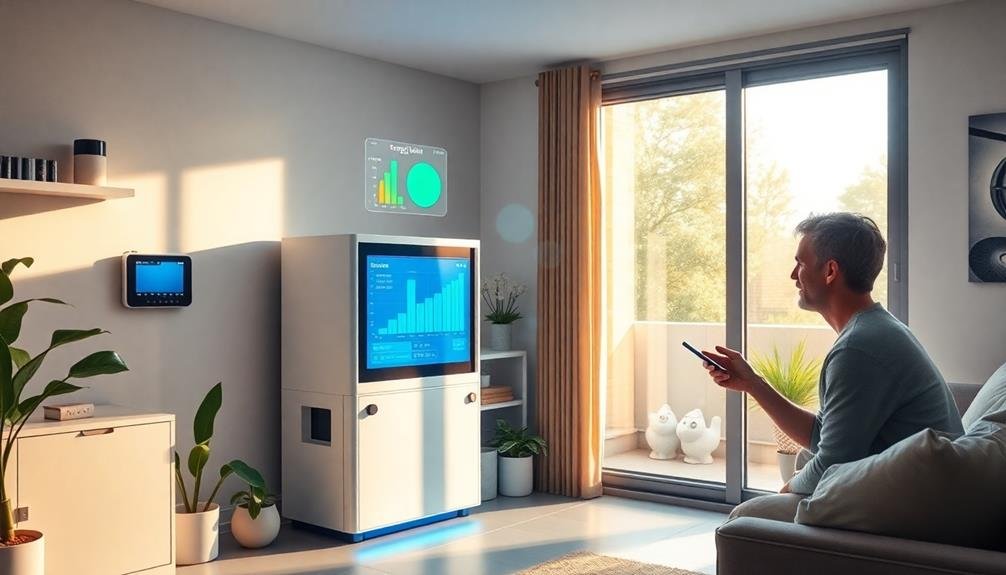Monitoring your home fuel cell's performance is essential for optimizing efficiency, detecting problems early, and maximizing cost savings. You'll be able to track energy production, guarantee safety, and assess environmental impact. Regular checks help extend your system's lifespan and allow you to benchmark performance against manufacturer specifications. By keeping a close eye on your fuel cell, you can plan maintenance schedules, evaluate grid independence, and make informed decisions about energy consumption. Proactive monitoring not only prevents costly repairs but also guarantees your home fuel cell operates at peak efficiency. Discover how a well-monitored system can revolutionize your home energy management.
Efficiency Optimization

To maximize the performance of your home fuel cell system, efficiency optimization should be your top priority. Regular monitoring allows you to identify and address factors that may reduce your system's efficiency.
Keep an eye on fuel consumption rates, electrical output, and heat production to guarantee your fuel cell operates at peak performance.
You'll want to track the system's overall efficiency, typically expressed as a percentage. This figure represents how much of the fuel's energy is converted into usable electricity and heat.
Modern residential fuel cells can achieve efficiencies of up to 90%, but various factors can cause this to decline over time.
Pay attention to your fuel cell's operating temperature, as it directly impacts efficiency. Most systems perform best within a specific temperature range.
Monitor for any unusual temperature fluctuations that could indicate problems.
Regularly check for fuel leaks or contamination, as these can greatly reduce efficiency and pose safety risks.
Inspect connections and seals, and verify your fuel supply meets the required purity standards.
Early Problem Detection
Early problem detection is essential for maintaining your home fuel cell system's ideal performance.
By identifying issues before they escalate, you'll prevent system failures, maximize energy efficiency, and greatly extend your equipment's lifespan.
Regular monitoring and quick responses to anomalies guarantee your fuel cell operates at peak capacity, saving you money and reducing downtime.
Prevent System Failures
By implementing an effective early warning system, you can prevent catastrophic failures in your home fuel cell setup. Regular monitoring allows you to identify potential issues before they escalate into major problems. You'll be able to detect anomalies in temperature, pressure, or electrical output that might indicate impending system failures.
Utilize sensors and automated monitoring systems to track key performance indicators. Set up alerts for when these indicators deviate from normal ranges. This proactive approach enables you to address issues promptly, reducing downtime and repair costs.
| Warning Sign | Potential Issue | Action Required |
|---|---|---|
| Reduced power output | Degraded fuel cell stack | Schedule maintenance |
| Unusual noise | Faulty pump or fan | Inspect components |
| Increased fuel consumption | System inefficiency | Check for leaks |
Optimize Energy Efficiency
Vigilance is key when it comes to optimizing your home fuel cell's energy efficiency. By closely monitoring its performance, you'll be able to identify opportunities to improve its output and reduce waste.
Keep an eye on the system's electrical efficiency, which measures how much of the fuel's energy is converted into usable electricity. If you notice a decline in this ratio, it's time to investigate potential issues.
Track your fuel consumption rates and compare them to the electricity produced. Any unexpected increases in fuel usage without a corresponding rise in power output could indicate inefficiencies.
Monitor the heat-to-power ratio as well, ensuring you're making the most of both electricity and thermal energy generated by the fuel cell.
Pay attention to your fuel cell's response to varying loads. If it's struggling to meet peak demands or running inefficiently during low-usage periods, you might need to adjust your energy consumption patterns or consider energy storage solutions.
Regularly check the condition of filters, catalysts, and other components that can impact efficiency. By staying proactive, you'll maximize your fuel cell's performance, reduce operating costs, and minimize your environmental footprint.
Extend Equipment Lifespan
Regular monitoring of your home fuel cell system doesn't just enhance efficiency—it's a powerful tool for extending your equipment's lifespan. By keeping a close eye on your system's performance, you'll be able to detect potential issues early, preventing minor problems from escalating into major failures.
Early problem detection allows you to address small issues before they cause noteworthy damage. You'll notice subtle changes in efficiency, output, or operating parameters that might indicate wear and tear or developing faults. This proactive approach helps you schedule maintenance at the right time, avoiding unexpected breakdowns and costly emergency repairs.
Monitoring also helps you track the natural degradation of your fuel cell's components over time. You'll be able to plan for replacements or upgrades before performance notably declines. This strategy guarantees your system operates at peak efficiency throughout its lifespan.
Additionally, regular monitoring encourages you to maintain proper operating conditions, such as temperature and humidity levels. By consistently providing an ideal environment for your fuel cell, you'll reduce stress on the system and slow down wear and tear, further extending its useful life.
Cost Savings Opportunities

You'll find significant cost savings by closely monitoring your home fuel cell system.
By optimizing your energy consumption patterns and detecting inefficiencies early, you can reduce your overall energy expenses.
Regular monitoring also helps you anticipate and prevent costly maintenance issues, further decreasing your long-term operational costs.
Optimize Energy Consumption Patterns
Optimizing your energy consumption patterns can lead to substantial cost savings when using a home fuel cell system. By monitoring your fuel cell's performance, you'll gain valuable insights into your energy usage habits and identify opportunities for improvement.
Start by analyzing your daily and seasonal energy consumption trends. You'll likely notice peak usage times and periods of lower demand. Use this information to shift non-essential energy-intensive tasks to off-peak hours when possible. This balances your load and reduces strain on the fuel cell system.
Consider integrating smart home technologies to automate energy management. These can adjust heating, cooling, and appliance usage based on real-time data from your fuel cell monitoring system.
You'll also want to address any energy waste in your home, such as poor insulation or inefficient appliances.
Detect Inefficiencies Early
Early detection of inefficiencies in your home fuel cell system can lead to significant cost savings over time. By monitoring your fuel cell's performance regularly, you'll be able to identify and address issues before they escalate into major problems. This proactive approach helps maintain ideal efficiency and extends the lifespan of your system.
To detect inefficiencies early, focus on these key indicators:
- Power output: Monitor for unexpected drops or fluctuations
- Fuel consumption: Watch for sudden increases in fuel usage
- Operating temperature: Check for abnormal temperature changes
- System alerts: Pay attention to any warnings or error messages
By keeping a close eye on these factors, you'll quickly spot potential issues. For example, a gradual decrease in power output might indicate degrading components, while increased fuel consumption could signal a leak or inefficient conversion process. Unusual temperature fluctuations may point to cooling system problems or internal damage.
Don't wait for a complete system failure to take action. Regular monitoring allows you to schedule maintenance at convenient times, avoiding unexpected breakdowns and costly emergency repairs.
Reduce Maintenance Expenses
Proactive maintenance strategies can greatly reduce the long-term costs of operating your home fuel cell system. By monitoring your fuel cell's performance, you'll identify potential issues before they become major problems, saving you money on repairs and replacements.
Regular monitoring allows you to optimize your system's efficiency, reducing fuel consumption and extending its lifespan. You'll also be able to schedule maintenance at convenient times, avoiding emergency repairs that often come with premium pricing.
Here's a breakdown of potential cost savings through proactive monitoring:
| Area | Savings Opportunity | Impact |
|---|---|---|
| Repairs | Early detection | Lower repair costs |
| Efficiency | Optimized performance | Reduced fuel expenses |
| Lifespan | Prolonged system life | Delayed replacement costs |
Environmental Impact Assessment
Evaluating the environmental impact of home fuel cells is essential for sustainable energy adoption. By monitoring your fuel cell's performance, you'll gain valuable insights into its environmental footprint. This data allows you to make informed decisions about your energy consumption and its effects on the ecosystem.
Regular evaluations help you track your fuel cell's efficiency and emissions over time. You'll be able to identify any changes in its environmental impact and take corrective actions if needed. This proactive approach guarantees that your home energy system remains eco-friendly throughout its lifespan.
Consider these key factors when evaluating your fuel cell's environmental impact:
- Greenhouse gas emissions reduction compared to traditional energy sources
- Water consumption and management
- Air quality improvements in your local area
- Lifecycle analysis of fuel cell components and materials
Energy Production Tracking

You'll want to keep a close eye on your home fuel cell's daily output to guarantee it's meeting your energy needs.
By analyzing efficiency trends over time, you can identify any performance declines and take action promptly.
Monitor system health indicators regularly to catch potential issues before they become serious problems, maintaining peak performance of your fuel cell.
Daily Output Monitoring
In light of the importance of tracking your home fuel cell's performance, daily output monitoring is crucial. By keeping a close eye on your fuel cell's daily energy production, you'll gain valuable insights into its efficiency and overall health. This practice allows you to identify potential issues early on and make informed decisions about maintenance or upgrades.
To effectively monitor your fuel cell's daily output, you'll need to:
- Record the energy produced each day
- Track fuel consumption rates
- Monitor the system's operating temperature
- Note any fluctuations in performance
By consistently collecting this data, you'll be able to establish baseline performance metrics for your fuel cell. You'll quickly notice if there's a sudden drop in output or an increase in fuel consumption, which could indicate a problem that needs attention.
Additionally, you'll be able to assess how external factors like weather conditions or seasonal changes affect your fuel cell's performance.
Daily output monitoring also helps you optimize your energy usage. You'll be able to identify peak production times and adjust your household's energy consumption accordingly.
This proactive approach guarantees you're making the most of your fuel cell investment while maintaining its longevity and efficiency.
Efficiency Trend Analysis
Building on your daily output monitoring, efficiency trend analysis takes your fuel cell performance tracking to the next level. This process involves examining your fuel cell's energy production over extended periods, typically weeks or months.
You'll track how much electricity your system generates relative to the fuel consumed, allowing you to spot gradual changes in efficiency.
To conduct an efficiency trend analysis, you'll need to record both your fuel cell's energy output and fuel input consistently. Use a spreadsheet or specialized software to plot this data over time.
Look for patterns or gradual declines in efficiency, which could indicate maintenance needs or system degradation. Compare your fuel cell's performance against manufacturer specifications and expected degradation rates.
Pay attention to seasonal variations, as temperature and humidity can affect fuel cell efficiency. You might notice lower efficiency during extreme weather conditions.
System Health Indicators
System health indicators serve as the vital signs of your home fuel cell, offering important insights into its overall performance and longevity.
By monitoring these indicators, you'll be able to identify potential issues early and take proactive measures to maintain your fuel cell's efficiency.
Energy production tracking is a significant aspect of system health monitoring. It allows you to observe your fuel cell's output over time and detect any deviations from expected performance.
You'll want to keep an eye on the following key metrics:
- Electrical output: Monitor the kilowatt-hours (kWh) generated daily
- Fuel consumption: Track the amount of natural gas or hydrogen used
- Operating temperature: verify it remains within the ideal range
- Voltage and current stability: Watch for any fluctuations or irregularities
System Lifespan Extension
Longevity is an important factor when considering home fuel cell systems. By actively monitoring your fuel cell's performance, you can greatly extend its lifespan. Regular checks allow you to identify potential issues early, preventing costly repairs and prolonging the system's overall efficiency.
You'll want to pay attention to voltage and current output, as well as fuel consumption rates. If you notice any deviations from normal operating parameters, it's time to take action. This might involve cleaning components, replacing filters, or adjusting fuel flow rates. By addressing these issues promptly, you're effectively adding years to your fuel cell's life.
Don't forget about proper maintenance schedules. Following manufacturer recommendations for servicing and parts replacement is vital. You should also keep an eye on environmental factors that can affect your fuel cell's performance, such as temperature and humidity. By maintaining ideal conditions, you're reducing stress on the system and promoting longevity.
Lastly, consider upgrading your monitoring equipment periodically. Newer technologies can offer more precise data, helping you make informed decisions about your fuel cell's operation and maintenance needs.
Safety Assurance

Safety stands as the cornerstone of any home fuel cell system.
By monitoring your fuel cell's performance, you're taking proactive steps to guarantee the safety of your household and the longevity of your investment. Regular checks help identify potential issues before they escalate into dangerous situations.
You'll be able to detect abnormal operating conditions, such as unusual temperatures or pressure levels, which could indicate a malfunction or leak.
Monitoring also allows you to:
- Verify that safety systems are functioning correctly
- Detect any hydrogen leaks promptly
- Guarantee proper ventilation in the fuel cell's location
- Maintain ideal operating conditions to prevent accidents
Performance Benchmarking
Performance benchmarking goes hand in hand with safety monitoring, allowing you to track your fuel cell's efficiency and output over time. By establishing baseline performance metrics, you'll be able to identify any deviations that might indicate potential issues or declining efficiency.
Start by measuring your fuel cell's electrical output, fuel consumption, and heat production. These key indicators will help you assess its overall performance. Compare your unit's actual performance to the manufacturer's specifications to guarantee it's operating as intended.
Keep a log of your fuel cell's performance data, including power generation, fuel usage, and operating hours. This information will help you spot trends and anticipate maintenance needs. You can use specialized software or apps designed for home fuel cell monitoring to simplify data collection and analysis.
Regular benchmarking allows you to optimize your fuel cell's performance by adjusting operating parameters or scheduling maintenance proactively.
It also helps you calculate your system's efficiency and cost-effectiveness over time, ensuring you're getting the most value from your investment.
Maintenance Schedule Planning

Your fuel cell's long-term reliability depends on a well-planned maintenance schedule. By creating and adhering to a routine maintenance plan, you'll guarantee peak performance and extend your system's lifespan.
Start by consulting your fuel cell's user manual for manufacturer-recommended maintenance intervals and tasks.
Develop an all-encompassing schedule that includes:
- Regular visual inspections for leaks, corrosion, or loose connections
- Filter replacements and cleaning of air intakes
- Checking and adjusting fluid levels
- Testing safety systems and emergency shutdown procedures
Remember to keep detailed records of all maintenance activities, including dates, tasks performed, and any issues encountered. This documentation will help you track your fuel cell's performance over time and identify potential problems early.
Consider using a digital maintenance management system to set reminders and store your maintenance history. These tools can help you stay on top of your schedule and provide valuable insights into your fuel cell's performance trends.
Don't hesitate to contact a qualified technician for more complex maintenance tasks or if you notice any unusual changes in your fuel cell's operation.
Regular professional inspections can complement your maintenance efforts and guarantee your system continues to operate safely and efficiently.
Grid Independence Evaluation
While maintaining your fuel cell is key, evaluating its ability to operate independently from the grid is equally important. Grid independence evaluation helps you assess your fuel cell's capacity to meet your home's energy needs without relying on external power sources. This process involves monitoring your fuel cell's output, efficiency, and reliability over extended periods.
To evaluate grid independence, you'll need to track your fuel cell's performance during peak demand times and varying weather conditions. Monitor its ability to handle sudden load changes and maintain stable power output.
You should also assess its energy storage capabilities, ensuring it can provide consistent power during periods of low fuel availability or system maintenance.
Keep a close eye on your fuel cell's fuel consumption rate and compare it to your household's energy demands. This will help you determine if your system can sustain long-term off-grid operation.
Additionally, evaluate the fuel cell's integration with other renewable energy sources, such as solar panels or wind turbines, to enhance its grid independence potential.
Frequently Asked Questions
How Often Should I Calibrate My Home Fuel Cell's Monitoring System?
You should calibrate your home fuel cell's monitoring system every 3-6 months. It's crucial to follow the manufacturer's guidelines, as they'll provide specific instructions. Regular calibration guarantees accurate readings and peak performance of your fuel cell system.
Can Weather Conditions Affect My Fuel Cell's Performance Readings?
Yes, weather can impact your fuel cell's performance readings. Temperature, humidity, and atmospheric pressure changes can affect efficiency and output. You'll want to take into account these factors when interpreting data from your monitoring system for accurate assessments.
What Software Is Best for Analyzing Home Fuel Cell Performance Data?
You'll want specialized fuel cell monitoring software for accurate data analysis. Popular options include FuelCell Analyst Pro and CellSight. These tools offer real-time performance tracking, graphing capabilities, and customizable alerts for ideal home fuel cell management.
Are There Professional Services Available for Interpreting Fuel Cell Performance Reports?
Yes, you'll find professional services available for interpreting fuel cell performance reports. They can provide expert analysis, helping you understand your data and optimize your system's efficiency. These services often offer remote consultations or on-site evaluations for thorough assessments.
How Do Fuel Cell Performance Metrics Compare to Traditional Energy Sources?
You'll find fuel cell performance metrics often surpass traditional energy sources in efficiency and emissions. They're typically measured in power output, efficiency, and durability. Compare these to conventional metrics like kilowatt-hours and carbon emissions for a thorough evaluation.
In Summary
You've seen how monitoring your home fuel cell's performance is essential. By staying on top of efficiency, issues, costs, and environmental impact, you're ensuring ideal operation. You'll track energy production, maintain safety, and benchmark performance effectively. Regular monitoring helps you plan maintenance and evaluate your grid independence. Remember, a well-monitored fuel cell isn't just about energy—it's about taking control of your home's power future and making informed decisions.





Leave a Reply